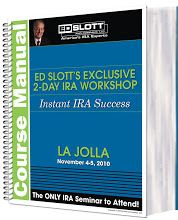Last week, our question of the week focused on Roth IRA contributions. In particular, we discussed the fact that there are still restrictions in place that, depending on your income, may prevent you from making direct contributions. If you missed last week’s post or just need a refresher, click here.
This week, as promised, we discuss a strategy for getting money into your Roth IRA each year, no matter how high your income.
If you have earned income in 2010 but have modified adjusted income over $120,000 (single filers) or $177,000 (joint filers), you will be completely phased-out of Roth contribution eligibility. That doesn’t mean there’s no way to get your extra $5,000 ($6,000 if you are 50 or older) IRA contribution into a Roth IRA each year to continue building your tax-free retirement savings though. It just takes a little more work. Instead of contributing directly to a Roth IRA account, simply follow the following two step process.
Step #1 - Make a contribution to a traditional IRA.
If you have earned income and are under 70 ½, you can ALWAYS make a contribution to a regular IRA. It doesn’t matter whether or not you participate in a company plan or how much you make. Plan participation, however, may affect your ability to deduct the IRA contribution.
Step #2 - Convert the traditional IRA contribution to a Roth IRA
There are still Roth contribution limits, but there are no more Roth conversion limits. So once you make your annual contribution to a traditional IRA, you can skirt the Roth contribution limits by simply making a Roth conversion of $5,000 ($6,000 if 50 or older) each year.
Sound too ridiculous to be true? Well, it may be ridiculous, but it’s also true. Of course, like anything else there are a few small traps you should be aware of.
Trap #1 - IRA conversions are subject to the pro-rata rule. If you have other IRA money (besides your new contribution) - including money in SEP and SIMPLE IRAs - and your contribution was non-deductible, you may end up owing more tax that year than you thought (because a portion of your after-tax dollars would remain in traditional accounts).
Trap #2 - Traditional IRA contributions have an age limit, Roth IRA contributions don’t. If you have earned income, regardless of your age, you may make a Roth IRA contribution. On the other hand, once you reach the year in which you turn 70 ½, you may no longer make traditional IRA contributions. Since the strategy above requires you first make a contribution to a traditional IRA, if you are over 70 ½, it’s not a strategy that can work for you.
Roth IRAs are a great way to accumulate funds for retirement and protect against the risk of rising taxes in the future. Indeed, there are many out there who want to get as much money as possible into Roths now, at today today’s tax rates. $5,000 (or $6,000) may not sound like much, but added together and compounded over time, it can make a significant difference in your future.
Got more questions?? Want to see what other people are asking? Check out the Ed Slott and Company IRA Discussion Forum.
By IRA Technical Consultant Jeffrey Levine and Jared Trexler
------------------------------------------------------------------------------
Comment, Question, Discussion Topic on your mind? Click on the Blue Comment Link below and leave your thoughts then check back to see what other consumers and advisors think.
*Copyright 2010 Ed Slott and Company, LLC
Friday, August 13, 2010
Roth IRA Contribution Confusion - Part II
Quality content
- Siti Non Aams
- Nuovi Siti Casino
- Casino Non Aams Italia
- Casinos Not On Gamstop
- Casino Sites Not On Gamstop
- Online Casino
- UK Casino Not On Gamstop
- Sites Not On Gamstop
- Casino En Ligne
- Casino En Ligne Fiable
- Casinos Not On Gamstop
- UK Casino Not On Gamstop
- Casino Sites Not On Gamstop
- Non Gamstop Casinos UK
- Casino Online Non Aams
- Casino Not On Gamstop
- Meilleur Casino En Ligne France
- Casino Sites Not On Gamstop
- Non Gamstop Casino Sites UK
- Casino Sites UK Not On Gamstop
- UK Casino Not On Gamstop
- Meilleur Casino En Ligne Fiable
- Casino Online Non Aams
- Casino Non Aams
- Casino Sites Not On Gamstop
- Meilleur Casino En Ligne Belgique
- Lista Casino Online Non Aams
- 안전한 파워볼사이트
- Meilleur Casino En Ligne 2026
- Meilleur Casino En Ligne 2026
- Meilleur Casino En Ligne
- Casino Senza Richiesta Documenti
Posted by
Ed Slott and Company, LLC
at
2:24 PM

 Labels:
Q of the Week,
Retirement,
Roth Contributions,
Roth IRAs
Labels:
Q of the Week,
Retirement,
Roth Contributions,
Roth IRAs
Subscribe to:
Post Comments (Atom)
















0 comments:
Post a Comment